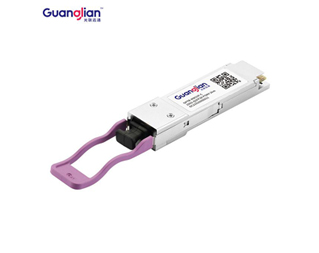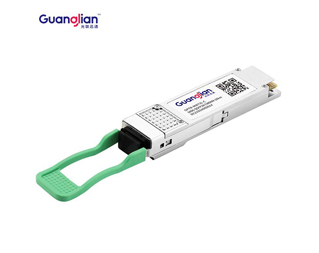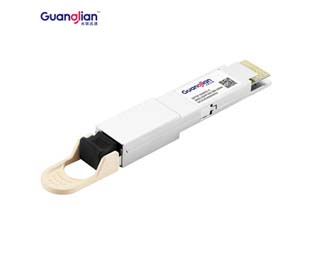200G QSFP56 optical module and 200G QSFP-DD optical module are two mainstream solutions for 200G optical interconnect. QSFP56 utilizes mainstream digital signal processors (DSPs) to help cloud data centers meet tough challenges and achieve more efficient optical interconnects with flexible scaling and low cost. This article will mainly introduce you to the optical module 200G QSFP56 package technology and the difference between the QSFP56 package and the QSFP28 and QSFP+ package.
Before understanding the QSFP56 package, let's take a look at the form factor of the QSFP package. QSFP, or Quad Small Form-Factor Pluggable, refers to a four-channel small hot-pluggable SFP interface, which was originally designed to replace single-channel SFP optical modules with high-density optical modules. Compared to SFP optical modules, QSFP optical modules have higher bandwidths.
200GBASE-QSFP56-SR4-100m Optical Transceiver Module
Developed from the QSFP package, 40G QSFP+ optical modules and 100G QSFP28 optical modules began to be gradually used in high-density data center network deployments. As data center traffic continues to grow and its bandwidth requirements increase, QSFP package types have emerged in more form factors, such as the 200G QSFP56 and 400G QSFP56-DD.
The 200G QSFP56 optical module is an upgraded version of the 40G QSFP+ and 100G QSFP28 optical modules and is designed specifically for 200G Ethernet interconnects. modules. According to different transmission distances, 200G QSFP56 optical modules are further classified into QSFP56 CR, SR, DR, FR, and LR, which can be used for different distances on single-mode and multimode fibers.
Generally, two 200G QSFP56 optical modules are inserted into the corresponding switch ports and connected with a single-mode or multimode fiber to achieve a 200G transmission rate. In addition, a 200G transmission can also be achieved by inserting a QSFP56 DAC/AOC high-speed cable into the corresponding port. If you want to achieve 2x100G or 4x50G transmission, you can use 200G QSFP56 to 2x100G QSFP28 branch cable and 200G QSFP56 to 4x50G SFP56 branch cable to achieve it.
100GBASE-QSFP28-LR4-10km Optical Transceiver Module
By name, QSFP56, QSFP28, and QSFP+ optical modules have the same package type, but they have different transmission rates, modulation techniques, interfaces, etc.
QSFP56 package type optical module can support 4x50G transmission to reach a 200G transmission rate. QSFP+ optical module is the upgraded version of the QSFP optical module, which can support 4x10G transmission to achieve 10G Ethernet, 10G Fibre Channel, and QDR InfiniBand transmission. It can multiplex four channels to increase bandwidth and achieve a 40Gbps transmission rate (10GBaud NRZ per channel). QSFP28 optical module, like QSFP+ optical module, contains 4 optical transmitters and 4 optical receivers to support 4x25G transmission, thus achieving a 100G transmission rate.
The major difference between the QSFP56 package and QSFP+ and QSFP28 package is that QSFP56 no longer adopts the previous NRZ modulation technology, but adopts PAM4 modulation technology, which can reach a 50G transmission rate per channel and can transmit more data on the existing fiber, which is more suitable for application in super-scale data center network.
With the rapid growth of data centers, the demand for data transmission is also increasing, prompting the network to move to higher bandwidth and higher density. Currently, there is a new generation of 400G optical module package type - 400G QSFP-DD, where "DD" refers to dual-density, which means the number of channels of 400G QSFP-DD changes from 4 to 8 and can achieve a 400G transmission rate. It can achieve a 400G transmission rate.
The size of the 400G QSFP-DD optical module is similar to the 200G QSFP56 optical module, but the 400G QSFP-DD optical module is backward compatible with the 40G QSFP+, 100G QSFP28, 200G QSFP56, and other QSFP packaged optical modules. In other words, 200G QSFP56 optical modules can work on 400G QSFP-DD ports as long as the switch supports them. When using a 200G QSFP56 optical module on a 400G QSFP-DD port, the switch's port will be configured for a 200G transmission rate instead of 400G.
For more information about the best 200G QSFP56 Optical Module, welcome to contact us today or request a quote.
100G CFP vs QSFP28: Which One to Choose?
Jun. 11, 2022What Makes the Best Optical Transceiver Module?
May. 27, 2022200G QSFP56 Optical Module Knowledge Full Explanation
Apr. 25, 2022
100G CFP vs QSFP28: Which One to Choose?
Jun. 11, 2022
What Makes the Best Optical Transceiver Module?
May. 27, 2022Copyright ©Guanglian Xuntong Technology Group Co., Ltd. All Rights Reserved | Sitemap
